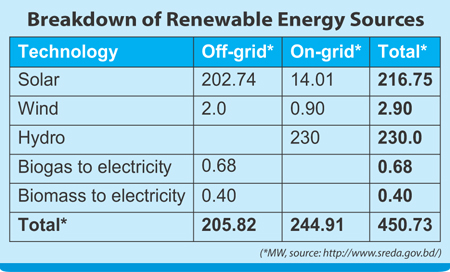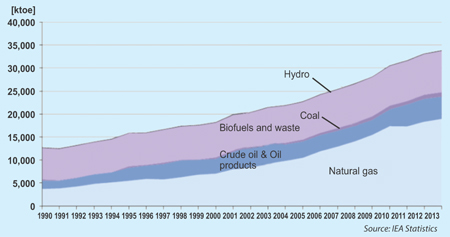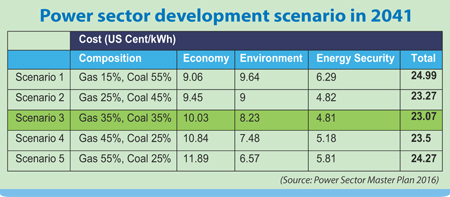 Sustainable energy has been one of the most-argued topics since the dawn of this millennium. Authorities working on sustainable energy often make dramatically opposing opinions. While working on sustainable energy, one cannot help wondering how experts in a particular field can develop such dichotomous views. One can also be curious about which of them is correct. In this article we will delve deep into the myths and realities of sustainable and renewable energy in the context of Bangladesh.
Sustainable energy has been one of the most-argued topics since the dawn of this millennium. Authorities working on sustainable energy often make dramatically opposing opinions. While working on sustainable energy, one cannot help wondering how experts in a particular field can develop such dichotomous views. One can also be curious about which of them is correct. In this article we will delve deep into the myths and realities of sustainable and renewable energy in the context of Bangladesh.
First of all, what is sustainable energy? Numerous definitions can be found in academic and journalistic literature; and the main two characteristics of sustainable energy in all of those are efficiency and renewability. The government of Bangladesh promotes these views on principle. As a result, the government of Bangladesh established the Sustainable and Renewable Energy Development Authority (SREDA) in 2012 to ensure the country's energy security for promoting renewable energy, energy efficiency and conversion (EEC). SREDA has an ambitious target of achieving an additional capacity of 3,200 MW by 2021. Currently, the power generation capacity from renewable sources is 450.7 MW, which is only 2.81 per cent of the total power generation capacity in Bangladesh.
 Even though SREDA does not define sustainable energy, the organisation does differentiate between two broad sources of energy-conventional and renewable. Conventional energy sources comprise oil, natural gas, coal and nuclear power while the renewable energy sources include sun (solar), wind, moving water-body (hydro), organic plants and waste materials (biogas and biomass). SREDA does not include earth heat (geo-thermal) as the source of renewable energy in Bangladesh. For this discussion, we will build on SREDA's idea of renewable energy sources because it represents the mix of resources to meet Bangladesh's energy needs for present and future generations.
Even though SREDA does not define sustainable energy, the organisation does differentiate between two broad sources of energy-conventional and renewable. Conventional energy sources comprise oil, natural gas, coal and nuclear power while the renewable energy sources include sun (solar), wind, moving water-body (hydro), organic plants and waste materials (biogas and biomass). SREDA does not include earth heat (geo-thermal) as the source of renewable energy in Bangladesh. For this discussion, we will build on SREDA's idea of renewable energy sources because it represents the mix of resources to meet Bangladesh's energy needs for present and future generations.
A number of academics and institutions have identified a number of energy myths. Vaclav Smil proposed eight myths in his book, Energy Myths and Realities; Drew Thornley presented ten myths in a book called Energy & the Environment: Myths & Factors. Both Smil and Thornley come from the conservative side of political spectrum. On the liberal side, ten myths were identified by Henning Thomsen. Though myths identified by Thornley and Smil are quite different from those of Thompson, they are not necessarily in disagreement, rather they focused on different aspects of an energy source on different time horizons. Even though we are yet to conduct any survey on the energy consumers in Bangladesh, we will extrapolate from these lists and apply them to Bangladesh fuel, energy and power market.
Myth 1: Solar and wind energy are less costly than other forms of energy. To analyse this myth, we need to compare the total cost per Kilowatt-hour (kWh) for different sources of energy in Bangladesh. The total cost is the sum of construction, production and decommissioning cost (decommissioning is only applicable for nuclear power plants).
 As seen from the chart above, solar energy is actually the most expensive source of energy, costing Tk 17.5 per kWh. All the cost of solar energy relates to construction cost. Hydro-electricity is the cheapest source of energy, costing Tk 2.38 per kWh. Natural gas and coal are also very cheap sources of energy with similar cost-around Tk 3.2 per kWh. HFO-based power plants and wind-powered energy sources are in the middle costing around Tk 7.7 and Tk 6.4 per kWh respectively. Thus, it can be concluded that solar and wind energy is currently more expensive than natural gas, coal and hydro-power in Bangladesh. However, it must be noted that the main source of non-renewable energy in Bangladesh is natural gas, the reserves of which will be depleted over the next 10 years, given no new gas-fields are discovered. On the other hand, the cost of solar and wind energy will decrease due to improved technology. Therefore, this myth, despite being unsubstantiated at present time, can be important in another time period.
As seen from the chart above, solar energy is actually the most expensive source of energy, costing Tk 17.5 per kWh. All the cost of solar energy relates to construction cost. Hydro-electricity is the cheapest source of energy, costing Tk 2.38 per kWh. Natural gas and coal are also very cheap sources of energy with similar cost-around Tk 3.2 per kWh. HFO-based power plants and wind-powered energy sources are in the middle costing around Tk 7.7 and Tk 6.4 per kWh respectively. Thus, it can be concluded that solar and wind energy is currently more expensive than natural gas, coal and hydro-power in Bangladesh. However, it must be noted that the main source of non-renewable energy in Bangladesh is natural gas, the reserves of which will be depleted over the next 10 years, given no new gas-fields are discovered. On the other hand, the cost of solar and wind energy will decrease due to improved technology. Therefore, this myth, despite being unsubstantiated at present time, can be important in another time period.
Myth 2: Renewable energy is the route to energy independence for Bangladesh. Despite the importance of expanding the base of renewable energy for environmental sustainability, this strategy is not feasible for Bangladesh in the next 25 years.
In Bangladesh, natural gas accounted for 29 per cent of energy supply in 1990, and increased to 57 per cent in 2010. However, domestic gas production did not increase much from 2011 and since then the increasing demand is mainly covered by crude oil and oil products. Energy demand is likely to grow rapidly in Bangladesh, but natural gas that accounts for more than half the country's energy demand is coming to a saturation point. Proponents of solar energy argue that dramatically increasing the solar panels in Bangladesh should be the approach to replace natural gas-based energy sources. The major strength of solar energy is that it is environment-friendly. Moreover, after the primary installation, maintenance and production costs are negligible. With all the benefits of solar energy, one can ask why it is not outstripping natural gas in meeting Bangladesh's electricity demand. The reason is the huge capital investment required for solar energy due to the costly purified-silicon semiconductor used in making these solar panels. Solar energy is significantly more expensive than other sources of energy. Another problem with solar energy is that its efficiency depends on the intensity of sunlight as cloud and air pollution can impact on electricity production. The rate at which sunrays are converted to electricity is also quite low and might never be sufficient to cover the rapidly increasing energy demand in Bangladesh. It should also be noted that solar power in Bangladesh is highly subsidised by the government through organisations such as IDCOL. If Bangladesh's energy sector is entirely privatised, the power-generating companies will need to invest billions of dollars in solar power to meet an appreciable portion of the country's energy demand.


That wind power will help Bangladesh become energy-independent can be another proposal. Except for HFO-based power plants and solar power, it is the most expensive source of power generation. Production and installation of wind turbines involves a large amount of capital up front, because most of the technology needs to be imported. Wind power is ineffective if the wind speed is not high enough. One wind turbine roughly produces 1.24 MW of power (US Wind Industry Market Report, 2011). Therefore, to meet 10 per cent of electricity demand, Bangladesh needs to install more than 1,300 wind turbines, which is a herculean task. A second issue associated with wind energy is transmission and road costs. Wind energy must be connected to an electrical grid that might be located in an area that is far from the wind turbine. These costs, in some cases, become higher than the cost of the wind turbine itself (American Energy Independence 2011).
Lastly, biofuel supporters argue that it could be a solution to meeting energy demand but ignore a myriad of issues related to biofuel, such as, energy output from biofuel is much less than the energy input to create biofuels (Pimentel and Patzek, 2005).
Unless some groundbreaking technology increases the efficiency of renewable energy, this source cannot be used to ensure energy independence in Bangladesh.
Myth 3: Use of coal and oil is not sustainable in future.
Before making the Power Sector Master Plan, 2016, the government of Bangladesh with help from energy experts of JICA developed five scenarios to evaluate the development of Bangladesh's power sector for the next 25 years. For this simulation nuclear power plants, power imports, hydropower plants, existing coal-fired power plants, existing oil-fired power plants and candidate coal, gas and oil-fired plants are considered fixed at 30 per cent. For the variable factor, it is assumed that 70 per cent of primary energy mix should come from gas and coal.
Energy statisticians have projected that fossil fuel will not remain a sustainable source of energy in case we continue our present rate of consumption, a statement that seems to be completely disparate to Bangladesh government's long-term energy sector plan. Well, who is wrong here?
Interestingly, the government of Bangladesh is most likely right to assume that various energy efficiency and conservation (EEC) plans will help reduce the reliance on oil and coal, and hereby lengthen their useful life prior to depletion. Bangladesh, similar to the world, is dependent on fossil fuel. This dependence creates several challenges for Bangladesh, such as fossil fuel's potential depletion and their negative contribution to environment. These are the factors forcing the government to reduce their reliance on fossil fuels, which will lengthen their useful life. Furthermore, multi-faceted EEC measures will help develop ways to reduce fossil fuels' environmental impact.
Bangladesh's energy demand will continue to increase with people's standard of living improving. Sustainable and renewable sources of energy will be explored in Bangladesh but we should remember that most of these alternative energy sources are yet to be efficient. Only if density, cost, efficiency and sustenance are improved, solar power, wind power and biofuel will cover our energy needs. Hence, whether we like it or not, fossil fuels will be needed in Bangladesh for the next 25 years.
The writer is currently working as an investment analyst at a multinational investment management firm in Dhaka.
© 2024 - All Rights with The Financial Express
